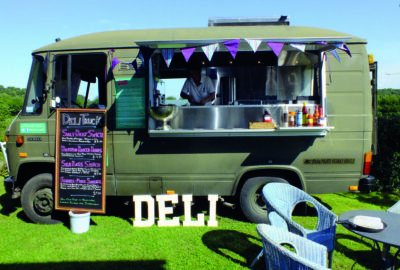Travelling the UK and Ireland with Tom Kerridge and Anna Haugh
We often talk about sourcing locally, but how often do you get the time to travel and meet local producers, and when you do – where do you start? Renowned chefs Tom Kerridge and Anna Haugh have both recently visited producers and cooks across the UK and Ireland, meeting inspirational farmers, growers and makers of some of our finest produce. In our exclusive feature article, they describe the abundance of ingredients and regional specialities they have encountered.
What draws you to source local ingredients?
Tom: Over the past few years, great chefs have been giving more reverence to great British & Irish ingredients. We’re in a place where we are more comfortable in our own skin. We spent years trying to replicate Mediterranean cuisine but we’re a northern European country. It’s cold, we need woolly jumpers. Root vegetables, smoking, curing, braising and slow cooking – they’re a better fit for us.
That doesn’t mean we don’t embrace global flavours and trends because let’s be honest, we’re almost magpie-like in how we take on food and food ideas. We now have two Michelin starred Indian restaurants that are using British ingredients with heritage style cookery and even our pubs embrace food from all over the world. In fact, nowhere else in the world could you have a Korean-style grilled mackerel starter, a slow cooked spiced lamb tagine for main and sticky toffee pudding for dessert – but that’s now normal in pubs.
Why is sourcing local so important?
Anna: Connecting with people isn’t just important for businesses, it’s vital for community and civilisation as a whole. I truly believe everything in life is better and more stable when you invest in building strong relationships.
Sourcing from your surrounding region is a great way of developing long-lasting relationships with the incredible producers and craftspeople in your area. Utilising their passion and skill can not only give you a unique selling proposition, boost your business and support the local community and economy, but it’s simply the right thing to do.
For me, it’s the connections with growers, farmers, producers, suppliers and customers that makes my job so inspiring and enjoyable. The relationships motivate me to be my best and in turn, help to reinforce quality and high standards from field to fork.
Ireland is blessed with fertile land and sublime coastal waters so there is a huge array of passionate producers and incredible ingredients available throughout the year.
Why should chefs get out of the kitchen and meet local producers?
Tom: It’s crucial that you meet your suppliers and find out about what makes them special. Chefs have to be active, do their research and knock on doors. Farmers, fishermen and markets operate early so you have to get out of bed and go and see them. It’s so important to meet people, shake hands, have conversations and build relationships. Learn how they work and their processes.
Most people involved in food are super passionate about what they do – the same as chefs. We all have this special connection to food and it is passion led so you will find you will meet a lot of like-minded people. Leveraging that local power can give your business, your building and your people something to build a narrative on and something to communicate and talk about.
Utilising their passion and skill can not only boost your business and support the local community, but it’s simply the right thing to do.
GUIDED TOUR with Tom Kerridge – England, Scotland & Wales
South West
The coast of Cornwall and Devon is rugged and the waters provide a melting pot of fish species. It’s not just traditional North Sea catches, it can be so varied. Plaice around Weymouth is sensational, Cornish sardines are stunning and line caught seabass is spectacular. With rich pasture, grassland and huge dairy herds, the milk, cream and cheeses available are also immense.
South East
A huge proportion of our vegetables are grown in Anglia on that flat fenland that works so well for arable farming. They are the best root carrots, beetroot, lettuce and cabbage you will find.
Drop down into Kent and you have superb shellfish and the famous Whitstable oysters. It’s also known as the garden of England thanks to its fruit trees and orchards offering so many different varieties of apples, pears and cherries.
North East
Rugged often inaccessible farmland where it is harder to survive means it’s great for pastures as opposed to arable crops. With these tough conditions, they produce some great beef. The fishing ports are also buzzing with the classic North Sea catches of the colder water fish such as haddock, cod, pollock and hake. Don’t forget Yorkshire’s unique forced rhubarb either.
North West
Some interesting things are happening in Ormskirk in Lancashire under polytunnels. Terrific tomatoes are being grown and mushroom farms are producing beautiful shitake mushrooms. In the Lakes, the Herdwick sheep are very special. The have to survive it tough so they’re like the SAS of sheep. The harder the living, the better they taste.
Scotland
Scotland’s cold, rough waters, hardy fisherman and ports like Peterhead have long been a bounty for great North Sea white fish. The shellfish, scallops, mussels and lobster are also amazing off the north coast where the water is cleaner and crisper.
Red fruits are another area of expertise in Scotland. Because of the longer days and colder nights, the Scottish strawberries and raspberries receive plenty more daylight and the cold nights are also beneficial. This is what separates Scottish red berries from any other in the world. They’re sensational. Game is another key part of country life in Scotland with the venison and grouse top draw.
Wales
The Welsh are well known for their lamb and it is exquisite but I visited some free range chickens in Wales recently, which were also sublime. Welsh seaweed is another ingredient that chefs are using and is frequently appearing on menus. The Welsh seem to have a great understanding of seaweed farming.
GUIDED TOUR with Anna Haugh -The Republic of Ireland and Northern Ireland
Northern Ireland
Based in Limavady in the north of Northern Ireland, Corndale make some of the best charcuterie you will find. Set up by the charcuterie-loving husband and wife team Alastair and Chloe Crown in 2012, the entrepreneurs bought a simple ‘how to make chorizo’ kit and the rest is history. Their ‘nduja and chorizo, made with special free-range saddle back pigs can stand up to anything.
South East or Ireland
At the height of summer when it is beautifully hot, there is no better strawberry on this planet than our wonderful Wexford Strawberries. As you drive through Wexford during the key season, the sides of the roads are full of sellers.
The West Coast of Ireland
The mineral content of the water, the temperature and the rough seas play their part in making Irish shellfish and oysters utterly delicious. We use Carlingford oysters because they simply can’t be beaten for flavour and I adore everything about Kian, his family and his amazing business.
Central Ireland – County Tipperary
Cais na Tire, which means country cheese, is an incredible cheese company in County Tipperary. The owners Barry and his wife Lorraine were given a herd of sheep when they got married and had enough interest and curiosity to focus on making cheese with the milk. They simply had the drive, dedication and passion to do it superbly and become masters. It’s sensational.
County Clare
There is magic in the air in the Burren, which is a limestone landscape that provides huge benefits to the animals grazing on it. In recent years, there has been a growing understanding of this special landscape and the ancient farming practices. With a multitude of flowers, fauna and lush grass, the region and its skilled producers have a reputation for rearing the finest beef and lamb but for me, the pork you will find is truly exceptional.
Cork
I think Ballymaloe is the reason why Cork’s food is so good. They are champions for traceability and provenance. Cork is famous for everything – charcuterie, lamb, beef, – it’s a food hub. The English market in particular is wonderful. In a world of over-sanitised and gentrified markets, this one still has that raw quality – the sounds, the smells, the vibrant colours and the farmers, growers and producers. I was there recently, and it was rammed to the brim of local people haggling and buying their bread, fish, meat and veg. The prices were reasonable, and you could see the connections. Discussions were going on everywhere between the consumer and the producers.



